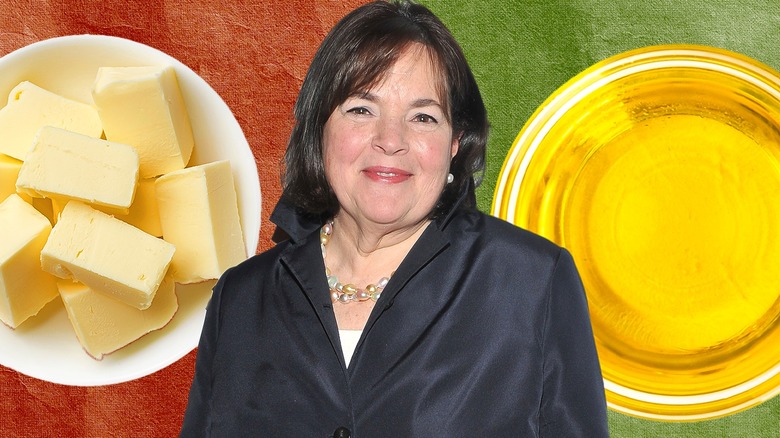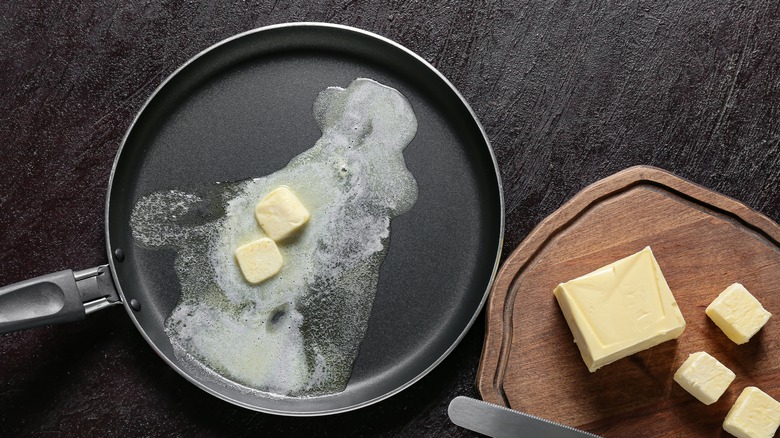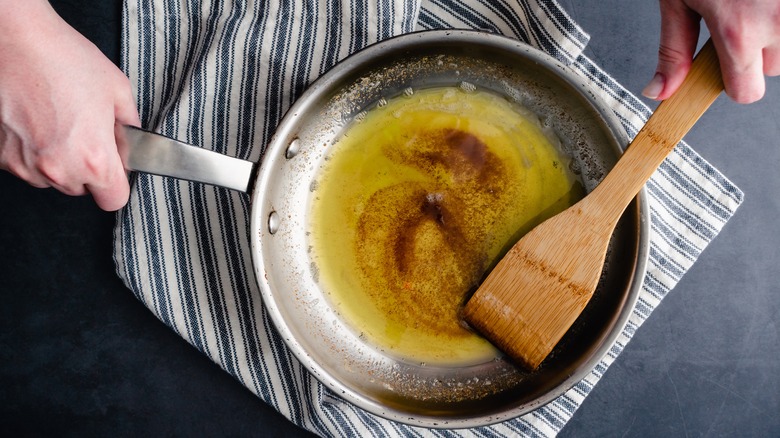Ina Garten's Answer To The Butter Vs Oil Saute Debate
We may receive a commission on purchases made from links.
To her devotees, Ina Garten's word is gospel, and for good reason. Her roasted chicken recipe is an absolute classic, and she has perfected the pound cake (thanks to her boozy, zesty secret ingredients). Along with this seemingly endless repertoire of food knowledge come some opinions that set her cooking style apart from the rest. In terms of sauteing, Garten has some pretty clear views on the butter versus oil debate.
While some cooks prefer using butter for its rich taste, others turn to a neutral oil with a high smoke point. However, Garten does not adhere to this dichotomous thinking. She chooses to use both. According to her 2018 book "Cook Like a Pro," "[c]ombining oil and butter gets the best of both worlds — the high burning point of oil for a golden and crispy crust and the delicious flavor of butter." So you really can get the best qualities of each, at least according to Garten. But does this assertion hold any weight?
As for the higher burning point, the claim is really more smoke than fire. Unfortunately, combining oil with your butter does not raise its smoke point, so you will still have to contend with burned milk solids in your dish. However, this doesn't mean that there is no benefit to combining both types of fat. So let's dig into why Garten prefers to add butter with oil.
For rich flavor, only butter will do
The thing about butter is — well — its flavor is simply irreplaceable. The luscious, slightly sweet, and creamy taste adds complexity and warmth to any dish. This does not, however, make it a good fat for cooking as it has a smoke point of 350 degrees Fahrenheit, making it less than ideal for use in pan frying and sauteing. So why, then, does Ina Garten use butter in her sauteed dishes? It all comes down to balancing flavor with practicality.
Garten showed off her sauteing hack in an episode of her series "Barefoot Contessa," in which she cooks up a downright delicious batch of shrimp scampi pasta (via YouTube). For this recipe, she combines both a large amount of oil and butter to create the base of her sauce.
She then adds both garlic and raw shrimp, which cook together to form the meal. For scampi, a simple butter-based sauce is often required. Cooking your shrimp in a combination of both fats helps bring out the buttery flavors while making sure the sauce doesn't taste acrid from burning. Then again, sauteing shrimp is less likely to result in smoking butter as the shellfish has a relatively short cooking time, so the milk proteins are less likely to burn. Even if they do brown, however, they will be diluted by the additional cooking oil, so this cooking method might just do the trick.
Why butter burns, and what to do about it
Though butter may seem on equal footing with choices such as vegetable or olive oil, it is actually pretty far removed from your typical cooking oil. For starters, butter has a much higher water content than most cooking oils. Additionally, butter has milk solids, which separate when cooked. This is great if you're making brown butter, but less so when sauteing.
These solids take on a bitter flavor when cooked for too long. Fortunately, there are a few ways to avoid this acrid taste. For starters, you can use clarified butter or ghee, which don't contain those pesky milk solids. However, these will not have the same warm taste as regular butter. If you'd like to use the standard, but don't want the burned taste, you can always add it in later in the cooking process. This will give flavor without risking separation.
However, there are some recipes for which those caramel, burned milk solid bits can actually be a benefit. They can add complexity to a hearty steak, for example. Slightly caramelized milk solids can benefit recipes such as Ina Garten's shrimp scampi pasta. Browning (not burning) your butter can add extra depth that takes your dish to the next level and, when diluted with olive oil, will taste balanced but have a silky smooth texture. So you should definitely give this method a go.


